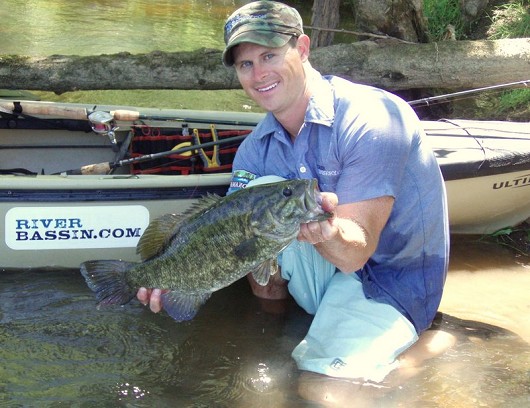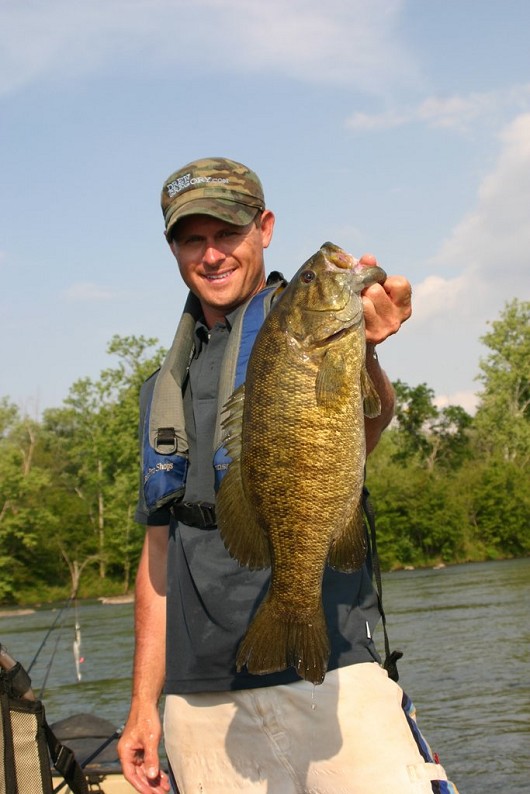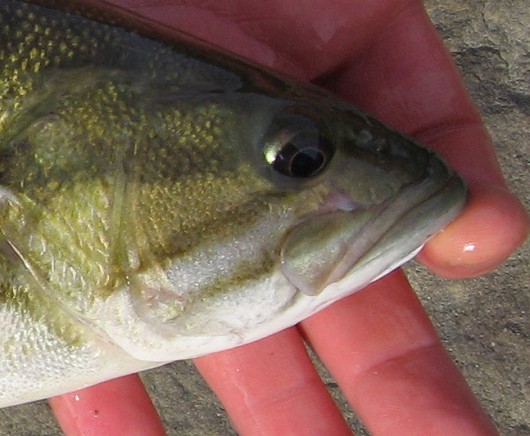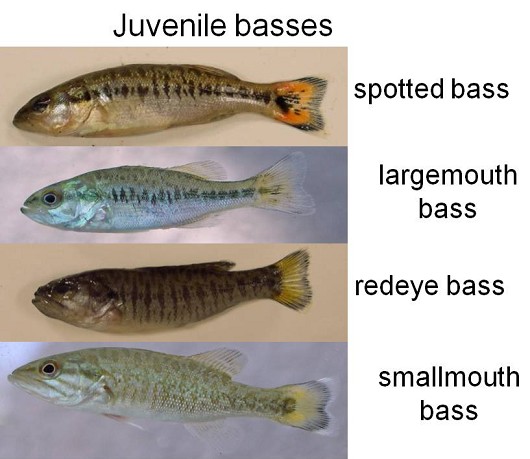Smallmouth Bass
-
Scientific NameMicropterus dolomieu
-
NativeNon-Native
-
Identification
 Smallmouth bass (horizontal). Photo courtesy of Drew Gregory.
Smallmouth bass (horizontal). Photo courtesy of Drew Gregory. Smallmouth bass (vertical). Photo courtesy of Drew Gregory.
Smallmouth bass (vertical). Photo courtesy of Drew Gregory. Smallmouth bass (showing maxilla) caught in Lake Berryessa Reservoir in March 2009 by Teejay O'Rear. Photo by Amber Manfree.
Smallmouth bass (showing maxilla) caught in Lake Berryessa Reservoir in March 2009 by Teejay O'Rear. Photo by Amber Manfree. Juvenile basses. Photos courtesy of Patrick Crain and Scott Matern.
Juvenile basses. Photos courtesy of Patrick Crain and Scott Matern.- Streamlined body
- Mouth does not reach hind margin of the eye
- Greenish brown to bronze body, occasionally with faint vertical bars of dark mottling and a white belly
- 3 dark, faintly iridescent bands radiate from the eye
- Young are darker with a tricolor tail
- 13-15 dorsal, 10-12 anal, and 16-18 pectoral fin rays
- 9-10 dorsal and 3 anal fin spines
- 66-78 scales on the lateral line
- Small scales on cheek in 14 or more rows and near the base of the dorsal and anal fins
-
Life History
Smallmouth bass are most common in large, clear lakes and cool, clear streams with large amounts of cover. In streams they prefer complex habitat with a variety of pools, riffles, runs, rocky bottoms, and overhanging trees, while lake populations concentrate in narrow bays along shore where rocky shelves project under water.Optimal water temperature differs with age as adults tend to stay in areas 25-27°C, while younger fish prefer areas 29-31°C, reflecting their more shallow water environment. Regardless of age, however, temperatures greater than 35°C are metabolically stressful and temperatures over 38°C are lethal. Smallmouth bass are also restricted in their habitat choice by the amount of dissolved oxygen in the water. While they can survive in areas with 1-3 mg of oxygen per liter they require at least 6 mg/L for normal growth rates. Juveniles and populations in crowded lakes may school, but this is rare and the majority are solitary hunters that stalk around some kind of submerged debris. This will localize populations to such a degree that several reproductively independent groups can exist within a single lake. Foraging occurs throughout the day but is most intense in the evening and the early morning. Crustaceans and aquatic insects make up the majority of a smallmouth bass’s diet until it reaches 3-5 cm TL, at which point crayfish and fish become more important. By the time an individual reaches 10-15 cm TL these larger food items will dominate the diet. Smallmouth bass are opportunistic, however, and insects, amphibians, and small mammals are not uncommon sources of food.
Smallmouth bass reach maturity in their third or fourth spring at which point they move into more shallow water. Spawning begins in May and can continue into June or July. Males construct nests 30-60 cm in diameter, preferably in rubble, gravel, or sand 1 m deep with submerged logs, boulders, and other submerged objects acting as cover. This is only the optimal environment, however, and nests can be found on a variety of substrates varying in depth from 0.5 m to 5 m. These nests may be built close together but they are not colonial and males will defend the nests against other males as vigorously as they would against predators. Spawning is initiated by a female repeatedly swimming by a nest, changing colors, and keeping her head down in a mating posture. Eventually the pair circle the nest with the male nipping at the female and the female occasionally rubbing her abdomen on the nest floor. The pair will then settle into the nest and release their eggs and milt simultaneously. Smallmouth bass are mostly monogamous but the larger fish spawn earlier in the season and may have the opportunity to spawn again. Each female may release 2,000-21,000 eggs into her nest. The males guard the embryos and fan water over them to provide more oxygen. After hatching it will take 1-2 weeks before fry become free swimming, and the male will still guard them for another 1-4 weeks after that until they are too active to be herded. At 2-3 cm TL the young will disperse to shallow water where high mortality rates are suffered due to predation and high stream flows. Those that survive generally grow to between 6 cm and 18 cm in their first year, and 25-41 cm in their fourth, with stream populations growing at a decidedly slower rate. The largest individual on record weighed 4.1 kg.
-
Links to Other ResearchN / A
-
WatershedN / A
Please note, watersheds are at the USGS 8-digit Hydrologic Unit Code (HUC) scale, so they often include a lot of sub-watersheds. If a species occurs in any sub-watershed within the HUC, the species appears within the HUC. Link to an EPA page that shows HUCs.



